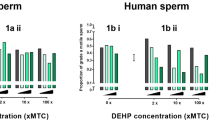Abstract
Single dosages of DMEP (1,000–2,000 mg/kg), GMCH (50 mg/kg), ECH (25 and 50 mg/kg), FA (100 and 200 mg/kg), and MMS (100–400 mg/kg) were administered orally to 10 week old male Wistar rats. The rats were necropsied on the 11th day following dosing. The testes were weighed, homogenised and sonicated; numbers of sperm heads (total and abnormal) were counted and percentage sperm head abnormalities were calculated. Testes weights were significantly reduced only in rats exposed to 1,500 and 2,000 mg DMEP/kg. Compared with controls, there were significant increases in the incidence of abnormal sperm at all dose levels of MMS and the higher dose levels of DMEP (1,500 and 2,000 mg/kg), ECH and FA. No texicologically significant effects upon total sperm counts were seen following the oral administration of any of the five chemicals tested. However, an additional group of rats given 100 mg MMS/kg intraperitoneally (i.p.) showed significant reductions in testes weight and total sperm head counts compared with control animals.
It is concluded that this testicular sperm head counting technique is a useful tool in the detection of selective adverse effects of chemicals upon testicular sperm but requires further evaluation.
Similar content being viewed by others
References
Auerbach C, Moutschen-Dahmen M, Moutschen J (1977) Genetic and cytogenetical effects of formaldehyde and related compounds. Mutat Res 39:317–362
Cassidy SL (1981) Rodent testicular sperm head count — a useful method of detecting cytotoxic agents in reproductive toxicology. Abstract, 8th European Teratology Society Conference, Munster, FRG. Teratology 24:35A
Epstein SS, Arnold E, Andrea J, Bass W, Bishop Y (1972) Detection of chemical mutagens by the dominant lethal assay in the mouse. Toxicol Appl Pharmacol 23:288–325
Fontignie-Houbrechts N (1981) Genetic effects of formaldehyde in the mouse. Mutat Res 88:109–114
Jones AR, Davies P, Edwards K, Jackson H (1969) Antifertility effects and metabolism ofα and epi-chlorohydrins in the rat. Nature 224:83
Meistrich ML, Reid BO, Barcellona WJ (1976) Changes in sperm nuclei during spermiogenesis and epididymal maturation. Exp Cell Res 99:72–78
Meistrich ML, Hunter NR, Suzuki N, Trostle PK, Withers HR (1978) Gradual regeneration of mouse testicular stem cells after exposure to ionising radiation. Radiat Res 74:349–362
Oishi S, Hiraga K (1980) Testicular atrophy induced by phthalic acid esters: Effect on testosterone and zinc concentrations. Toxicol Appl Pharmacol 53:35–41
Ramaniah TV, Nandan SD, Rao KP, Rao MS (1980) Mutagenicity of phenytoin in the male germ cells of Swiss mice. IRCS Med Sci Lib Compend 8:853
Silhanková L, Smid F, Cerná M, Davidek J, Velisek J (1982) Mutagenicity of glycerol chlorohydrins and of their esters with higher fatty acids present in protein hydrolysates. Mutat Res 103:77–81
Singh AR, Lawrence WH, Autian J (1974) Mutagenic and anti-fertility sensitivities of mice to Di-2-ethylhexyl Phthalate (DEHP) and Dimethoxyethyl Phthalate (DMEP). Toxicol Appl Pharmacol 29:35–46
Stolzenberg SJ, Hine CH (1979) Mutagenicity of halogenated and oxygenated 3-carbon compounds. Abstract in 18th Annual meeting of Society of Toxicology, New Orleans, USA. Toxicol Appl Pharmacol 48: part 2, A47
Stott WT, Watanabe PG (1980) Kinetic interaction of chemical mutagens with mouse sperm in vivo as it relates to animal mutagenic effects. Toxicol Appl Pharmacol 55:411–416
Topham JC (1980a) The detection of carcinogen-induced sperm head abnormalities in mice. Mutat Res 69:149–155
Topham JC (1980b) Do induced sperm head abnormalities in mice specifically identify mammalian mutagens rather than carcinogens? Mutat Res 74:379–387
Wyrobek AJ, Bruce WR (1975) Chemical induction of sperm abnormalities in mice. Proc Natl Acad Sci USA 72:4425–4429
Wyrobek AJ, Bruce WR (1978) The induction of sperm shape abnormalities in mice and humans. In: Hollaender A, de Serres FJ (eds) Chemical mutagens — Principles and methods for their detection, vol 5. Plenum Press, New York, pp 257–285
Author information
Authors and Affiliations
Rights and permissions
About this article
Cite this article
Cassidy, S.L., Dix, K.M. & Jenkins, T. Evaluation of a testicular sperm head counting technique using rats exposed to dimethoxyethyl phthalate (DMEP), glycerolα-monochlorohydrin (GMCH), epichlorohydrin (ECH), formaldehyde (FA), or methyl methanesulphonate (MMS). Arch Toxicol 53, 71–78 (1983). https://doi.org/10.1007/BF01460003
Issue Date:
DOI: https://doi.org/10.1007/BF01460003




